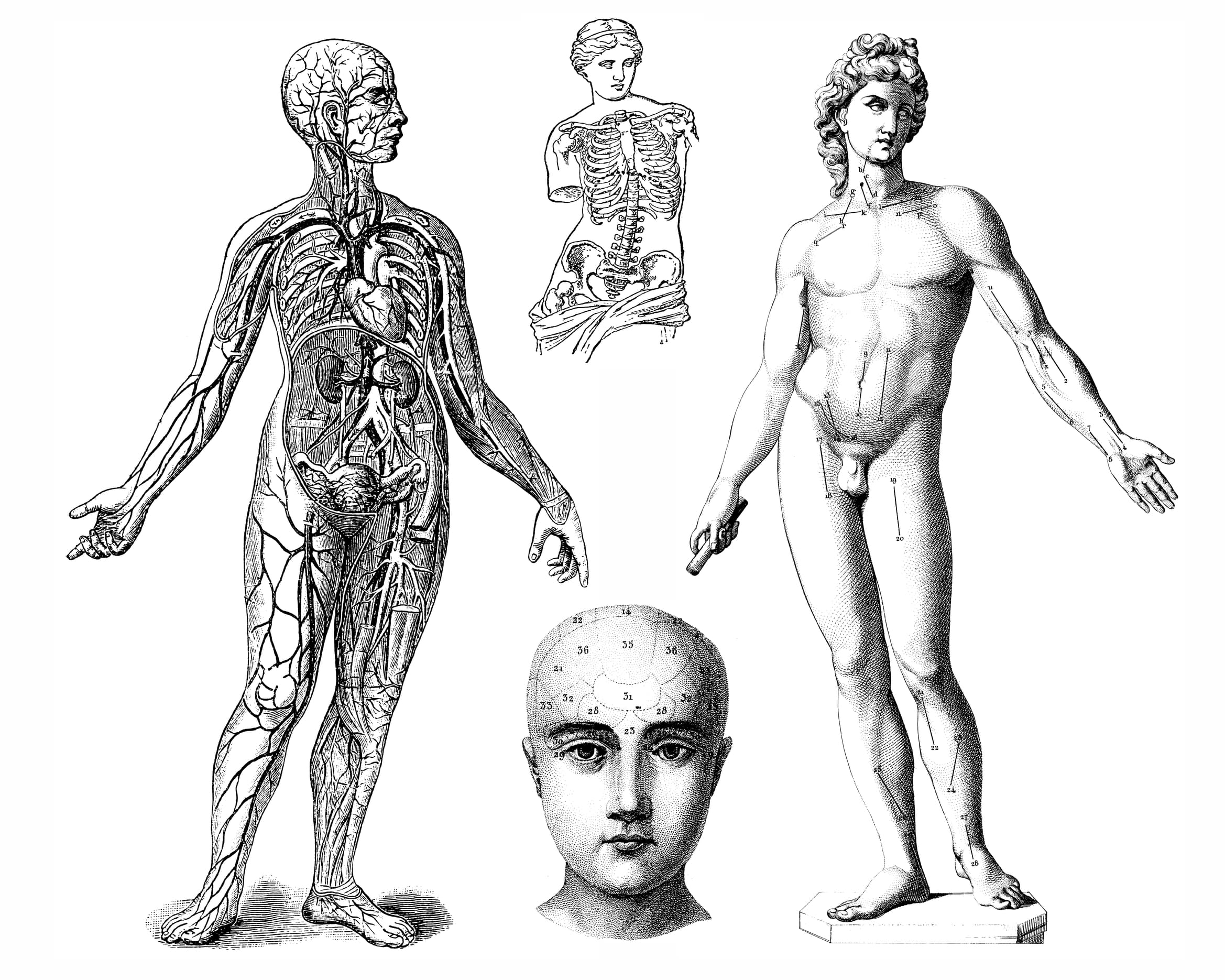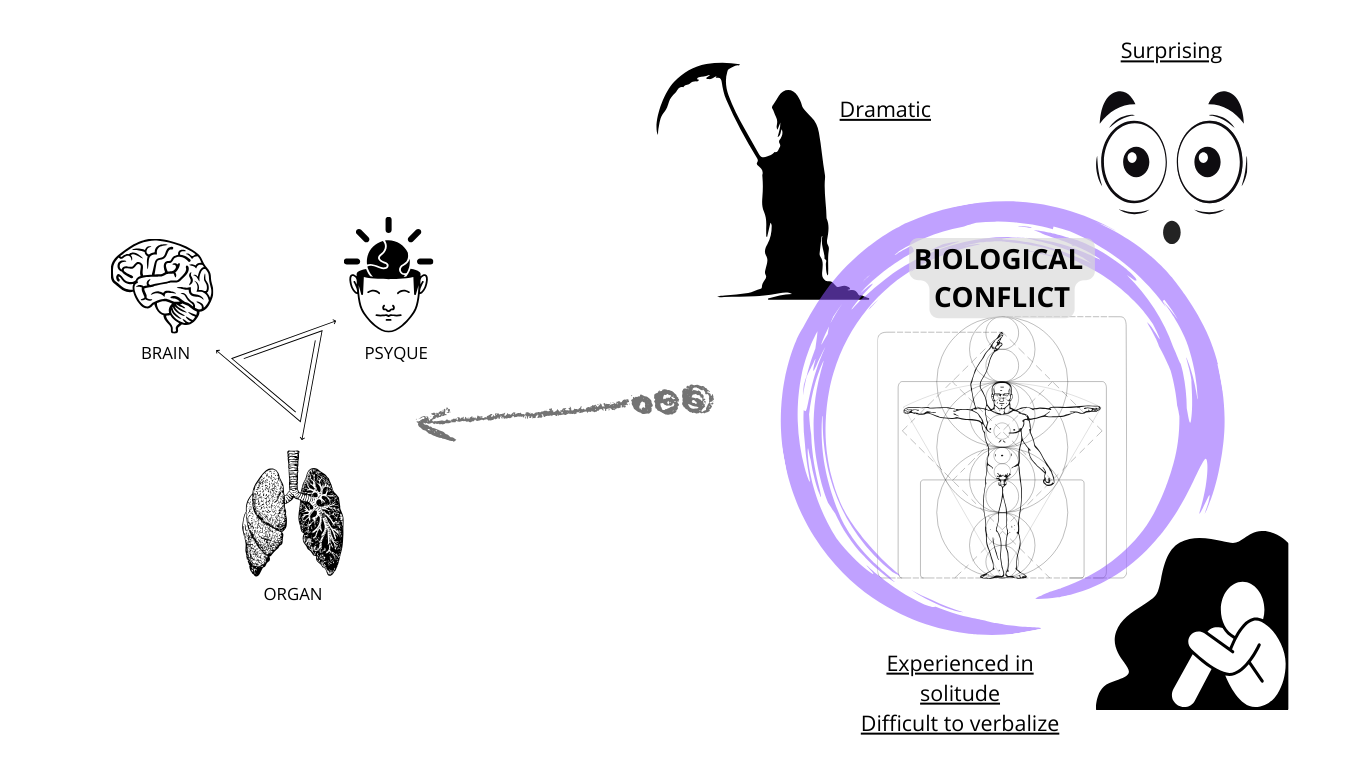GESTALT and GNM (German New Medicine)
If you’re dealing with any symptoms or illness, here’s a question that could open the door to a future consultation with me:
What does my body (or the part of it generating the symptom) know that I don’t yet know, or don’t want to know?

Organizing Experience from the Real
Both Gestalt Therapy, Logical Gestalt, and the concepts presented in Hive Mindset share a common denominator: they organize experience from the real, through the body. As Gestalt therapists, we are known for accompanying processes where “the body shouts what the mind silences” and for demonstrating how “the body keeps score.” Whether it’s dialoguing with organs using the method of psychiatrist Nana Snacke, or focusing on the bodily experience in the Contact Process during the radical Here and Now of the therapeutic session, we are the psychotherapy school that, in my opinion, has done the most work in translating the symptomatic.
Translating and Interpreting Are Not the Same
Today, there are many approaches attempting to address the somatic, such as Biodecoding, which, though not officially recognized, is quite popular. These approaches often offer interpretations that, at times, reinforce guilt for not “doing something right.”
Listening to your body is very different from that; anyone who has done Gestalt will agree. Translating, however, means being able to inhabit the original experience and from there offer descriptions as faithful as possible to that source.
This is why Gestalt processes take time — there is no pre-interpreted element we force to fit; instead, it’s an open process aimed at discovering the most authentic intention behind the symptoms.
The great challenge is to reach the psychological conflict by correctly translating the BIO-logical conflict, helping reintegrate the person into their healthy wholeness. And along the way, new perspectives improve our ability to “speak bodily.”
Organs, Brain, and Psyche
German New Medicine (NMG) represents a shift in the logic governing the connection between organs, the brain, and the psyche.
A doctor named Ryke Geerd Hamer “biologized” psychological readings related to the somatic, linking them to embryology and the autonomic nervous system. In his first theory of NMG, he states that everything we call illness is produced by surprising, dramatic events that are impossible to verbalize (DHS / Dirk Hamer Syndrome), which create a biological conflict.
This conflict synchronously produces a survival brain program that generates a specific organic response and a psychic state of concern. In other words, there is a direct relationship between “what happens,” “how we perceive it,” and “how biology resolves it in its own way.”
Activation of Safe Programs
If we are not equipped to deal with the conflicts we face, biology will activate its “safe programs,” biologically resolving that specific challenge. For example, in the case of a territorial loss conflict, there may be an increase in urine production (since, in the animal kingdom, marking territory is essential). Biologically, the issue is resolved, with more urine available, but if we fail to translate what’s happening, we “interpret” it as an illness. This is how we enter vicious cycles, feeding anxiety due to the expression of biology, whose meaning we have yet to grasp.
We could think of the DHS as an intense stimulus that hasn’t been fully registered. In therapy, we help “close” that Gestalt, complementing the work of medicine, not replacing it.
Example of Conflict Reduction/Transformation
The following example illustrates how psychological intervention could reduce or transform the perception of a conflict in such a way that biology doesn’t activate its survival programs, fostering a more conscious and less somatic processing of the conflict.
Case: Marta, 45 years old, receives an unexpected call: her eldest son was arrested for a drug-related issue. The news was so shocking and overwhelming to Marta that it left her speechless, experiencing a mix of anxiety and shock. This unexpected and dramatic event represents what is known in NMG as Dirk Hamer Syndrome (DHS).
Without Therapy
Biological Conflict:
Marta experiences this situation as a “nest conflict,” typical for a mammal that feels its ability to protect and maintain its home has been threatened. The anxiety and fear for her son’s well-being trigger a specific biological conflict in Marta.
Affected Organ:
In terms of NMG, this type of conflict often affects the mammary glands, whose embryological origin is related to the ectoderm and responds to an ancient biological program of protection and provision for offspring. In response to this conflict, cells in the mammary glands begin multiplying in preparation to nourish and protect the child. This cellular growth manifests in Marta as a small lump in her left breast, which would medically be diagnosed as a breast tumor.
Biological Response:
In Marta’s case, biology has activated an ancient survival program to try to resolve the perceived conflict: protecting her son and ensuring his well-being. This automatic bodily mechanism acts synchronously with the emotional state of shock, seeking to enhance Marta’s maternal protective abilities. However, Marta doesn’t understand this biological response and perceives the lump as an even greater threat, generating a secondary conflict of fear about her own illness and creating a vicious cycle of anxiety, worsening the original conflict.
Variation: Marta with Psychological Therapy
Now let’s assume Marta had been in therapy for a while before this traumatic event. Her therapy had focused on developing emotional resilience and working on her beliefs of self-sufficiency and protection in relation to her family. This preventive psychological intervention helped her understand that not all problems her children face depend solely on her, and that her role as a mother can have healthy limits without compromising her love or care.
Biological Conflict with Psychological Support:
When Marta receives the call about her son, she still feels intense concern and is deeply affected by the situation, but thanks to her prior therapy work, she is able to identify her emotional reaction and recognizes that this issue does not directly threaten her protective role in such an immediate way. This reduces the perception of a “threat to the nest” and, with it, the activation of the survival program related to the mammary glands.
Although Marta goes through an emotionally painful process, her biology does not interpret the situation as a direct threat to her maternal protective function, so the cellular growth in her mammary glands is not triggered. Her reaction, though intense, remains at a psychological level and can be managed without triggering a significant biological response. Furthermore, the therapeutic support afterward allows her to find ways to manage her anxiety and help her son without developing a physical symptom, maintaining a greater sense of healthy wholeness.
In Psychology, we cannot guarantee results, as this is impossible and therefore unethical. However, it is obvious that getting to know oneself fully and working on the mature coherence between thoughts and actions is an inevitable source of Well-being.
What About Psychology Then?
The Good:
Psychologists have a vast field open to us with this shift in logic, as any therapeutic work that reduces psychological conflicts in people acts as a preventive measure for better positioning in the face of a (inevitable-eventually) DHS.
Let’s remember that in Gestalt, we emphasize how we PERCEIVE reality. In other words, we collaborate with the person’s maturity so they can meet their evolutionary challenges. On the other hand, any therapeutic space helps prevent the third condition of a DHS: experiencing events in isolation without the possibility of verbalizing them; and often, it also contributes to the second, lowering the intensity of the dramatic nature of what has occurred. The added value increases significantly when the therapist also assists in discovering the biological and psychological needs associated with it.

The Not-So-Good:
Unfortunately, the risk of entering into interpretations is still very high, though not so much in Gestalt settings where our premise is the PERSON’S EXPERIENCE, not the therapist’s explanation.
Furthermore, there is still much to research regarding biological readings, and thus, there may still be confusion about psychological or biological conflicts. Traditional medicine remains in conflict with NMG, and psychology, as always, supports the processes without intruding into other areas of responsibility.
German New Medicine, with its 5 Biological Laws, is an invaluable complement for seriously studying the body’s language. I am currently on that path. It is a complex field, but a major breakthrough for those of us in Gestalt, who patiently follow organic wisdom without falling into hasty human interpretations. Understanding animal biology, in my view, immunizes against the chaos reigning in many current alternative therapies.
For now, I can offer you specific support only within the framework of Gestalt Therapy, where we always start with the body, focusing on listening to what your biology is manifesting in order to reduce your suffering. The benefits of these new perspectives are clear: we will step away from the dramatic but with responsibility, entering a process of naming what until now only the body could do, and we will weave new resilient stories from trauma, from a renewed version of both patient and therapist.
How wonderful Gestalt Therapy is!
We will never know how much prevention occurs when a human being is allowed to express themselves authentically, as many problems dissolve before they even manifest.


BOOK A GESTALT THERAPY SESSION
RESERVE YOUR SESSION HERE